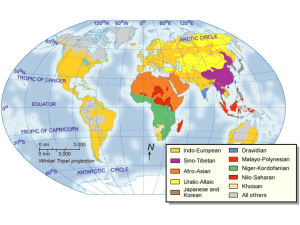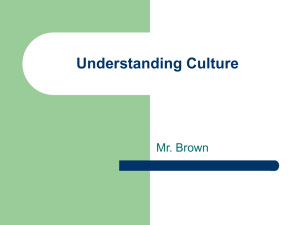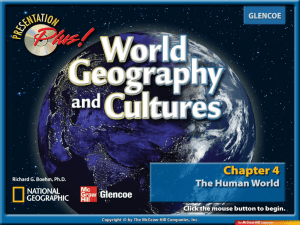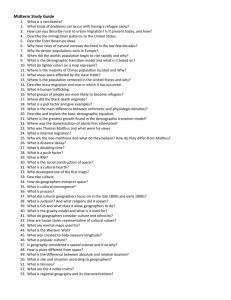World Geography and Cultures
advertisement
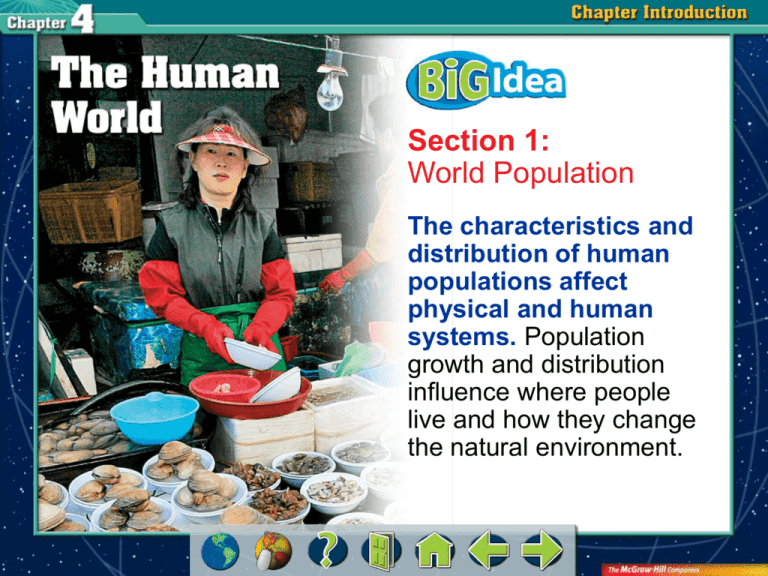
Section 1: World Population The characteristics and distribution of human populations affect physical and human systems. Population growth and distribution influence where people live and how they change the natural environment. Section 2: Global Cultures The characteristics and distribution of cultures influence human systems. The spatial interaction of cultures can spread new ideas, establish trading relationships, cause wars, and build political partnerships. Population Growth Population growth varies from country to country and is influenced by cultural ideas, migration, and level of development. • Nearly 6.5 billion people now live on Earth, inhabiting about 30 percent of the planet’s land. • Global population is growing rapidly and is expected to reach 9 billion by the year 2050. Population Growth (cont.) • The Demographic Transition – The demographic transition model uses birthrates and death rates to show changes in the population trends of a country or region. – Most of the industrialized and technologically developed countries have reached zero population growth, in which the birthrate and death rate are equal. The Demographic Transition Model Population Growth (cont.) • Rapid population growth presents many challenges to the global community: – difficulty producing enough food to feed everyone – a shortage of resources – an uneven distribution of age Population Growth (cont.) • Countries, such as Hungary and Germany, have experienced negative population growth, in which the annual death rate exceeds the annual birthrate. Population Distribution World population distribution is uneven and is influenced by migration and the Earth’s physical geography. • Almost everyone on Earth lives on a little less than one-third of the planet’s land. Population Distribution (cont.) • Population Density – To determine population density in a country, geographers divide the total population of the country by its total land area. – This does not account for uneven population distribution. World Population Density Population Distribution (cont.) • Population Movement – Many people are moving to urban areas. – The primary cause of urbanization is the desire of rural people to find jobs and a better life in more prosperous urban areas. – Population movement also occurs between countries. Urban Growth in Selected Cities Elements of Culture Geographers divide the Earth into culture regions, which are defined by the presence of common elements such as language and religion. • A particular culture can be understood by looking at the following elements: – Language – Religion World Language Families Elements of Culture (cont.) – Social Groups – Government and Economy – Culture Regions World Culture Regions Cultural Change Internal and external forces change cultures over time. • The Agricultural Revolution – The shift from hunting and gathering food to producing food is known as the Agricultural Revolution. – Some of the farming villages evolved into civilizations. Cultural Change (cont.) – The world’s first civilizations arose in culture hearths. • The most influential culture hearths developed in areas that make up the modern countries of: – Egypt – Iraq – Pakistan – China – Mexico World Culture Hearths Cultural Change (cont.) • They have certain geographic features in common: – Mild climate – Fertile land – Located near a major river or source of water Cultural Change (cont.) • Cultural contact among different civilizations promoted cultural change as ideas and practices spread through trade and travel. Cultural Change (cont.) • Industrial and Information Revolutions – In the late 1700s and 1800s some countries experienced the Industrial Revolution, which led to social changes. – At the end of the 1900s, the information revolution opened doors for experiencing new cultures. World Population • Population growth increased rapidly, but unevenly throughout the twentieth century and into the twentyfirst century. • The world’s population is unevenly distributed. Large numbers of people are migrating from rural areas to cities for jobs or to escape famine and war. • As people become more mobile, so do goods. Countries trade to gain access to resources they lack. World Culture • Language, religion, social groups, government, and economic activities define cultures. • Geographers divide the Earth into specific culture regions. • Trade, migration, war, and technology can change cultures. • The world’s first civilizations arose in culture hearths in Central America, Africa, and Asia.
